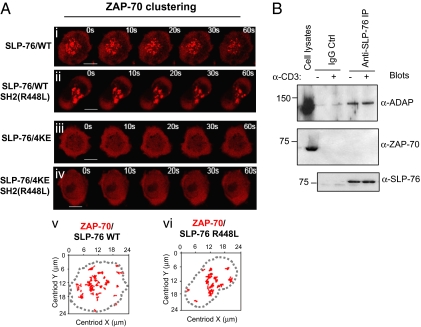Fig. 2.
Putative SLP-76 SH2 domain binding to ZAP-70 is detectable and cannot account for SLP-76 regulation of ZAP-70 clustering (A) Inactivation of the SH2 domain in the SLP-76 4KE mutant failed to alter its ability to disrupt ZAP-70 clustering. Time-lapse confocal images of ZAP-70 microclusters formation at the interface between transfected J14 Jurkat T cells and antigenic coverslips. ZAP-70-mRFP was coexpressed in cells with SLP-76 WT (i), SLP-76-SH2-(R448L) (ii), SLP-76–4KE (iii) or in SLP-76–4KE-SH2 (R448L) (iv). Panels are representative of at least eight cells. (Scale bars, 10 μm.) The movement of ZAP-70 individual cluster in cells over expressing SLP-76 WT (v) or SLP-76 R448L (vi) over the time course was tracked. The dotted line indicates boundary of T cell/coverslip interface. (B) SLP-76 fails to coprecipitate ZAP-70. SLP-76 was immunoprecipitated by anti-SLP-76 monoclonal antibody from Jurkat cells in the presence or absence of anti-CD3. The immunoprecipitates were subjected to SDS/PAGE, immunoblotted using anti-ADAP (Top); anti-ZAP-70 (Middle); anti-SLP-76 (Bottom).

